

Carex aestivalis - (image 1 of 6)
Taxonomy
Family: Cyperaceae
Section Hymenochlaenae
Habitat
Dry to mesic woods, wooded slopes, meadows in mountains.
Associates
Distribution
NH and VT to NC, KY, GA, and AL.
Morphology
Tufted perennial; stems 40-90 cm, purplish at the base; main leaves 2-3 mm wide, usually sparsely hairy; sheaths hairy, at least ventrally; terminal spikes pistillate in the upper half; lateral spikes 2-4, pistillate, usually overlapping, cylindric, 2-4 cm long and 2-3 mm wide, erect or nearly so, the lower on peduncles to 2 cm, the upper more or less sessile; upper bracts sheathless or nearly so; pistillate scales oval to obovate, half as long as the perigynium, obtuse or short-cuspidate; perigynia narrowly ellipsoid, 2.6-3.5 mm, 1/3 as wide, obscurely several-nerved, tapering to an obtuse beakless apex; achene concavely trigonous.
Notes
Fruiting June to August
Wetland indicator: NA
Similar to C. gracillima which also has beakless perigynia but differs from most other members of section Hymenochlaenae in having pubescent lower leaf sheaths. The spikes also tend to be more erect.
References
Ball, P.W. and A.A. Reznicek. 2002. Carex, In: Flora of North America Editorial Committee, Eds. Flora of North America North of Mexico. Volume 23. Oxford University Press, New York.
Gleason, Henry A. and A. Cronquist. 1991. Manual of Vascular Plants of
Northeastern United States and Adjacent Canada. Second Ed.
The New York Botanical Garden. Bronx, NY
|
© Michael Hough 2018 |